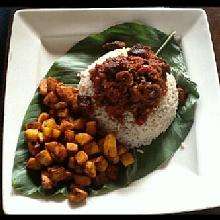Ofada rice

Ofada rice is a name for a heritage variety of rice grown in south-west Nigeria.[1] It is grown almost exclusively in Ogun State,[1] a state in Southwestern Nigeria. It is named after the town Ofada in Ogun State. Ofada rices are mostly blends, and are not indigenous to Africa. It is often served with a vegetable stew.
Overview
Ofada rices are mostly blends, and usually contain Oryza glaberrima (African rice) as well as the more common Oryza sativa Asian rice, and may be categorized as either brown/red Ofada or white Ofada on the basis of unmilled seed colour.[2] Grain size, shape, and shade vary.[2]
Ofada rice is unpolished.[1] As African rice is more difficult to mill and polish, some or all of the rice bran is left on the grain, strengthening the flavour and making it more nutritious. Brown ofada rices are often very highly aromatic, whereas white ofada rice is typically non-aromatic.[1] They are also known for swelling in size when cooked.[1] It is sometimes processed using fermentation, which adds an aromatic quality to the product.[1]
Ofada rice is typically priced higher compared to other available rices, and it has been regarded as a sign of status symbolism by some people.[1] In contemporary times, it is sometimes served at classy parties.[1]
History
Ofada rice has been grown in Ogun State since the 1940s.[1] It is not indigenous to Africa.[1] It is purported to have been smuggled by a soldier into Nigeria when the soldier returned from Asia and planted the rice in Ofada.[1]
Etymology
Ofada rice is named after the town Ofada, where it's cultivation first occurred.[1] Ofada is located in Ogun state.[1]
Preparation
Ofada rice is traditionally served in an uma leaf (Thaumatococcus daniellii), with a sauce of ‘Atarodo’ (spicy) and 'Tatase’ (sweet) pepper, onion, locust beans, palm oil, and meat. It is a festive meal rather than an everyday type of food.[2] It is also often served along with a vegetable stew that may contain locust beans as an ingredient.[1]
Use in pharmaceuticals
The starch in Ofada rice can be used in pharmaceutical delivery.[3][4]
References
- 1 2 3 4 5 6 7 8 9 10 11 12 13 14 Gyimah-Brempong, K.; Johnson, M.; Takeshima, H. (2016). The Nigerian Rice Economy: Policy Options for Transforming Production, Marketing, and Trade. University of Pennsylvania Press. pp. 30–31. ISBN 978-0-8122-9375-3.
- 1 2 3 PrOpCom Making Nigerian Agricultural Markets Work for the Poor Monograph Series # 26 DEFINITION OF OFADA RICE QUALITIES THROUGH VARIETAL IDENTIFICATION AND TESTING By National Cereals Research Institute (NCRI) Badeggi P.M.B. 8, Bida, Niger State, Nigeria (J. C. Anounye, N. Danbaba, A.S. Gana and M. E. Abo) And Africa Rice Centre, (WARDA), c/o International Institute of Tropical Agriculture. PMB 5320, Oyo Road, Ibadan, Nigeria (G. Gregorio, O.A. Oladimeji, B. Athanson, O. Ajayi, and F.E. Nwilene ) August, 2007
- ↑ Okunlola, Adenike; Ogunkoya, Temitope O. (18 May 2016). "Acetylated Starch of Ofada Rice as a Sustained Release Polymer in Microsphere Formulations of Repaglinide". 11 (1): 1–12. Retrieved 12 September 2016 – via openjournalsystemsng.com.
- ↑ Okunlola, Adenike; Owojori, Temitope (24 March 2016). "Impact of degree of substitution of acetylated Ofada rice starch polymer on the release properties of nimesulide microspheres". 7 (1): 4–16. Retrieved 12 September 2016 – via ojs.abo.fi.
Further reading
| Wikibooks has a book on the topic of: Cookbook:Cuisine of Nigeria |
| Wikimedia Commons has media related to Cuisine of Nigeria. |
- "Dieticians Urge Nigerians To Eat Ofada Rice To Reduce Life Threatening Diseases". Nigerian Television Authority. July 18, 2016. Retrieved September 12, 2016.
- Okuku, Mitchelle (February 1, 2016). "8 nutritional benefits of eating ofada rice". Naij. Retrieved September 12, 2016.